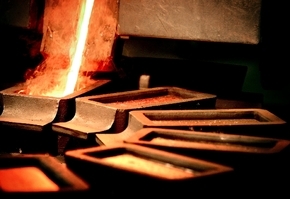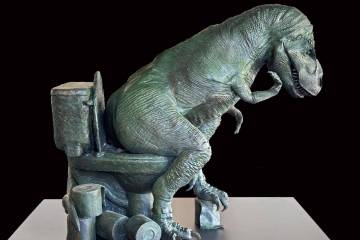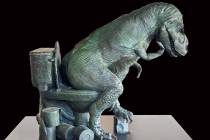Investors boost gold assets in world’s top ETF by most since ’11
Investors are piling back into gold. And they’re coming in droves.
Holdings in SPDR Gold Shares, the world’s largest exchange-traded fund backed by gold, surged 20.8 metric tons on Monday, the biggest one-day expansion since 2011, data compiled by Bloomberg show. About $7.1 billion in new money poured into SPDR Gold this year, the most of any ETF tracked by Bloomberg around the world, as holdings soared to the highest since 2013.
Bullion prices traded above $1,300 an ounce Monday and Tuesday, before closing lower. Prices have rallied 22 percent this year, as investors returned to the precious metal after three straight years of losses that were the worst run since 1998. Sentiment turned as risks to the global economy prompted the Federal Reserve to signal it will take a slow approach to raising interest rates. Lower rates are a boon to precious metals, which don’t offer yields or dividends. A weaker dollar has also helped gold.
“If we have a close of $1,300 or better, you’re going to start to see more fund managers and asset allocators getting questions from shareholders” about whether they have gold in their portfolio, George Gero, a managing director at RBC Wealth Management in New York, said in a telephone interview. “Continued worries about China, continued worries about the euro zone, keep interest rates benign, keep currencies weak, and so investors are looking for liquid, convertible gold to help them through this period.”
But gold retreated on Wednesday. The May futures price tumbled $17.40 to $1,273.30 on the Chicago Mercantile Exchange.
The European Commission warned on Tuesday of slower-than-predicted growth across the 19-nation bloc and urged the area’s largest economies to reduce debt and modernize labor markets. In China, a private gauge of manufacturing slipped in April, underscoring pockets of weakness in an economy weighed by overcapacity and weak external demand. The Bank of Japan refrained from adding stimulus last week, hurting the dollar and helping boost the appeal of the precious metal as alternative assets.
The likelihood of higher U.S. rates by year-end is 55 percent, down from about 93 percent in January, futures data show. The “new normal” for interest rates might be lower than the Fed’s median estimate, San Francisco Federal Reserve President John Williams said at a conference on Monday.
The U.S. expanded just 0.5 percent in the first quarter, the slowest pace in two years. This week, the release of monthly employment figures will provide clues on the strength of the world’s biggest economy and help shape the outlook for U.S. monetary policy.
Hedge fund manager David Einhorn said his stake in gold is poised to generate profits as central banks around the world continue to ease monetary policy. Discussing the results for reinsurer Greenlight Capital Re Ltd. Tuesday, Einhorn criticized the European Central Bank’s “kitchen-sink policy” of record-low borrowing costs, expanded asset purchases and borrowing subsidies.
He also said the Bank of Japan’s negative interest rate policy and reduced forecasts for U.S. rate hikes may contribute to boosting the value of gold.
Gold plays a key role in the Nevada economy. Gold production in Nevada fell to less than 5 million ounces in 2014, the first time since 1988 that output of the precious metal has dipped so low.
A state Division of Minerals report shows 4.94 million ounces of the precious metal was taken from 30 Nevada mines in 2014. There was about 5.5 million ounces of gold produced in Nevada in 2013. The peak year in recent memory was 1998, with just under 9 million ounces.
In 2013, Nevada accounted for 74.5 percent of all U.S. gold production and helped make the U.S. the third-leading gold producer in the world. Nevada accounted for 6.1 percent of world gold production, according to the Nevada Mining Association.
The Review-Journal contributed to this report.




























